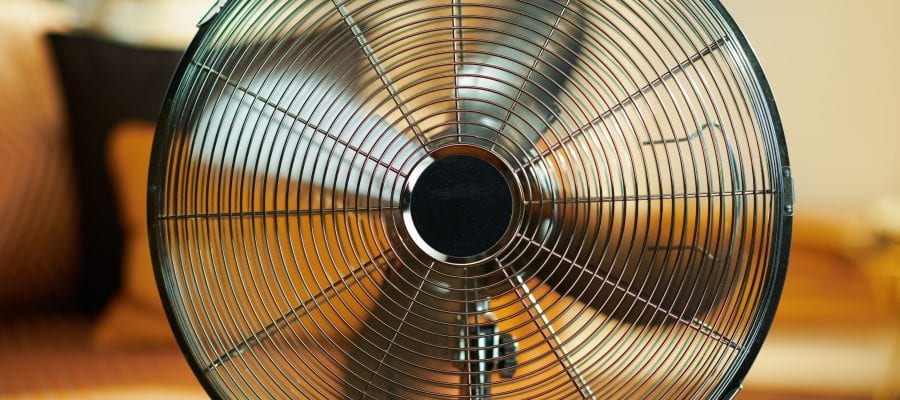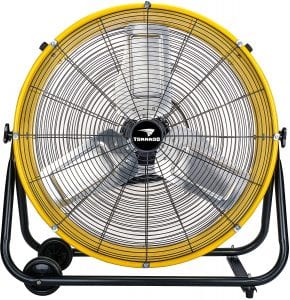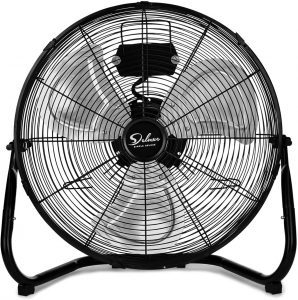The Best High Velocity Fan

Our Review Process
Don't Waste Your Money is focused on helping you make the best purchasing decision. Our team of experts spends hundreds of hours analyzing, testing, and researching products so you don't have to. Learn more.
Our Picks For The Top High Velocity Fans
- 1. Lasko Bedroom Pivoting High Velocity Fan, 20-Inch
- 2. Holmes Compact Tilt Head Personal High Velocity Fan, 5.9-Inch
- 3. AmazonCommercial Desk Top Aluminum High Velocity Fan, 20-Inch
- 4. Comfort Zone Corded Electric Manual High Velocity Fan, 12-Inch
- 5. HealSmart Manual Tilting High Velocity Fan, 20-Inch
- 6. Ozeri Brezza III Ultra-Quiet High Velocity Fan, 10-Inch
- 7. Tornado Electric OSHA Compliant High Velocity Fan, 24-Inch
- 8. B-Air Indoor/Outdoor Metal High Velocity Fan, 20-Inch
- 9. STANLEY Built-In Circuit Breaker Cooling High Velocity Fan, 12-Inch
- 10. Lasko Widespread LED High Velocity Tower Fan, 35-Inch
- 11. Simple Deluxe Basement Reinforced Wire High Velocity Fan, 12-Inch
- 12. Maxx Air Steel Tilting High Velocity Fan, 24-Inch
- 13. STANLEY Multidirectional Wall High Velocity Fan, 24-Inch
- 14. Patton 3-Speed Air Circulation High Velocity Fan, 18-Inch
This high velocity fan offers the utmost convenience with its QuickMount System. It has three powerful speeds and a fully pivoting head to direct air.
Versatile ChoiceThis high velocity fan can be quickly mounted to the wall or kept on the floor.
Although just 4 inches tall, this high velocity fan is quite powerful. It provides a steady breeze to keep you cool on those hot summer afternoons. Sit the compact fan on your desk, nightstand or coffee table and adjust the head to your preferred angle and relief is just seconds away.
Economical PickThe affordable price tag on this high velocity fan won't break your budget.
Whether you run a gym or work out of a warehouse, this high velocity fan will keep the atmosphere cool and comfortable. The fan is constructed using a strong metal frame and rust-resistant aluminum blades. It's easy to assemble and offers three speed settings.
Strong BreezeYou can get this high velocity fan in either 18 or 20 inches.
The handle on this high velocity fan makes it easy to transport, which is perfect if you're a painter or cleaner who moves from room to room. The unit is black in color and built with three fan speeds. There's also the option to tilt the fan up to a 180-degree angle.
Easy to Move AroundThis high velocity fan works best as a floor fan as it stands 12 inches tall.
Buying Guide
If you work in construction or need to dry out a room fast, then a high-velocity fan is right for you.
According to Vicki Liston, host of “On The Fly…DIY,” an award-winning home improvement and DIY show, “High-velocity fans dry out carpet and flooring after a flood, decrease the amount of time it takes for paint to dry and can even cut down on the amount of time you run your air conditioner.”
She also notes that, unlike regular fans, high-velocity fans can get a bit noisy. “While they’ve been historically louder than the traditional box or tabletop fans, manufacturers have come a long way in decreasing the amount of operational noise,” says Liston, “If you are considering a high-velocity fan, your focus is likely on airflow output rather than the amount of background noise it generates.”
When you’re purchasing a high-velocity fan, you need to keep in mind the size of the space you’ll be using it in. Also, consider the kind of task you want the fan to accomplish.
“CFM, or cubic feet per minute, measures the airflow output,” says Liston, “The higher the number, the more robust your gale force.” If your fan will typically be used for air circulation and cooling in a smaller room, say between 150-200 square feet, 2,000-2,500 CFMs may work just fine, says Liston. Rooms in the 200-250 square foot range would find around 3,000-3,500 CFMs to be a respectable amount of airflow. Larger rooms, between about 300-350 square feet, should opt for a higher number, like in the 4,000-4,500 CFM range, Liston notes.
In addition, you’ll need to consider whether you’re using the fan to dry out moisture or circulate air.
“Jobs that require more focus, like drying out carpet and flooring, should automatically go with a higher CFM,” says Liston. “Most high-velocity fans have three standard settings: low, medium and high, with the high setting reflecting the CFM number.”
In addition to the CFM, you’ll want to look at the kind of frame and mount your high-velocity fan comes with. This will affect how you use the fan and where you keep it.
“High-velocity fans come in either frame-mounted, pedestal-mounted, wall-mounted and window-mounted options,” says Liston. “The frame-mounted are the most common and usually the most versatile.” Attached to a metal frame, these fans can be angled with precision and easily moved from task to task, Liston says. “I don’t recommend any frame-mounted fan that has a tilt angle of fewer than 120 degrees,” says Liston. “Anything under that minimizes your flexibility and airflow focus.” A 360-degree tilt angle will allow you to adapt to any direction you choose, explains Liston. You’ll also need to take a look at the frame itself to make sure it reduces noise. “Ensure the metal frame comes equipped with rubber pads to minimize sliding, cut down on noise, and absorb the fan’s vibrations,” she says.
When you’re looking to circulate air above floor level, you need a different kind of mount. “Pedestal-mounted fans stand several feet off of the floor and are best only when the situation absolutely requires the airflow level to be higher. The tilt angle is much lower on a pedestal fan; however, they usually compensate for that drawback with adjustable height and oscillating features,” says Liston. When using a pedestal fan, you need to keep safety in mind at all times. “While they are weighted down, the potential to knock over a pedestal-mounted version is still present so take extra care while operating,” warns Liston.
You’ll also find some wall-mounted high-velocity fans on the market. “Wall-mounted fans are usually stationary, have some tilt angle flexibility and are best for circulation and cooling,” says Liston. “Some frame-mounted fans actually have a wall mount option, so I’d recommend considering these for their multi-surface application,” notes Liston.
Those with large windows can consider a window-mounted high-velocity fan. “Window-mounted are just that — they sit in a window frame. Select a model that installs on the frame but doesn’t hinder your ability to open and shut the glass as needed,” says Liston. “You shouldn’t have to haul the fan out in order to close the window. While they don’t offer tilt angle as a feature, they do have the unique capability of reversing the airflow. You can choose to bring in fresh air when your home is stuffy or blow out existing air when someone burns the popcorn.”
Our Expert Consultant

Home Improvement Expert
Vicki Liston writes, produces, and narrates “On The Fly…DIY,” an award-winning home improvement and DIY show of unique project tutorials for the casual DIY’er.
Home improvement and all things DIY have been Liston’s passion since she bought her first house in 2007 and she started making video blogs in 2014. She’s performed hundreds of DIY projects, from small ones to major, wall-smashing renovations and can teach you how to make a trendy DIY barn door for cheap. The proceeds earned from “On The Fly…DIY” are donated to no-kill animal shelters and rescue organizations.
What to Look For
- When finding the best high-velocity fan for your needs, you’ll want to pay attention to the blade size. “Look for a high-velocity fan with long, wide blades. The longer and wider they are, the more air they can crank out,” says Liston. “Fan blades normally range between about 12-20 inches with some as long as 24 inches. With the same size motor, a 12-inch fan blade will definitely move the air around but a 20-inch will blow you away in comparison.”
- Make sure that the fan you’re interested in has the speed you need to do the task at hand. Some fans offer three powerhouse speeds, which give them the power of a high-velocity blower fan. Many also have a wide pivot angle so you can aim the air where you need it to go.
- When buying your high-velocity fan, keep convenience in mind. “I recommend looking for two additional features when purchasing a high-velocity fan: a long power cord and an intelligently-placed control panel,” says Liston. “Do you want to have to pull out an extension cord every time you need to run your fan? If not, look for one with a 10-foot power cord. You may still need that extension in some instances, but 10 feet is normally more than enough for many tasks. ”The placement of the control panel will also make your life easier. “The control panel should be located anywhere on the body of the fan except one place — the back. Even a small panel placed on the back can impede the incoming airflow, which is exactly what you don’t want in a high-velocity fan,” explains Liston.
More to Explore
Are high-velocity fans good for everyone? There are some specific uses where a high-velocity fan is necessary. One of the most common places you’ll see a high-velocity fan being used is on a construction site. A high-velocity fan is useful for circulating the air and ensuring no harmful particles are being breathed in by the workers. If you’re in the carpet cleaning business, then a high-velocity fan can help you remove any excess moisture from the carpet after cleaning. If there has been a flood in your home, then a high-velocity fan can help you rapidly dry out the floor, walls and ceilings.
























